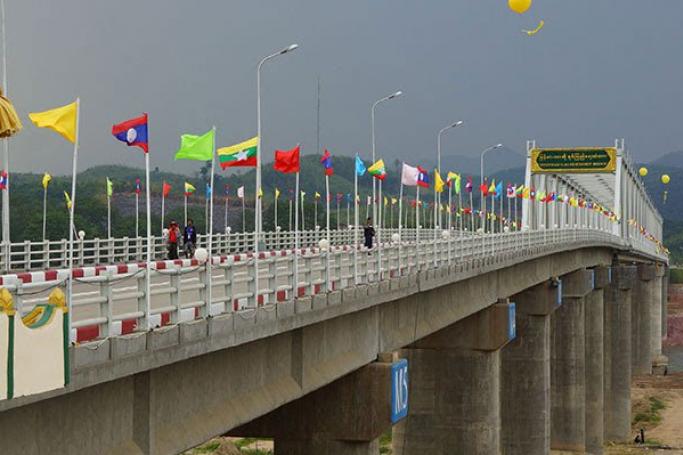Officials from Thailand, Myanmar, Laos, and China are raising concerns that the Myanmar-Laos Friendship Bridge, which officially opened last month,could bring the risk of increased drug trafficking along the routethe Chiang Rai Times reported on 23 June.
The bridge linking Tachilek in Myanmar’s Shan State to Luang Namtha district in Laos is also known as part of Route R3B, which connects Thailand, Myanmar, and China. The route links to the R3A Highway, which runs through Thailand, Laos and Xishuangbanna in southern China.
The Friendship Bridge abets trafficking networks, particularly in the northern areas of Shan State where several ethnic minority groups produce drugs, said Pol Col Myint Thein, deputy secretary-general of the Myanmar Central Committee for Drug Abuse Control.
Thailand, Myanmar, Laos, and China have devised more stringent measures to battle the illicit trade, particularly precursors in drug production, through the Safe Mekong Joint Operation, a project carried out by the four governments to crack down on narcotics production and distribution in the upper Mekong region and Golden Triangle.
Raids are being launched in areas near the bridge as part of the second phase of the project.
Representatives from the four countries met last week to review progress on the operation at the Myanmar-Laos Friendship Bridge. They included Pol Col Myint and Permphong Chavalit, secretary-general of the Office of the Narcotics Control Board (ONCB).
A local law enforcement officer, who declined to be named, said caffeine (a precursor to methamphetamine) has been smuggled across the bridge several times since its opening. Twenty-one tonnes of caffeine pills, which would have produced 500-600 million speed pills,were confiscated.
Mr Permphong said the R3B and the R3A Highways are popular routes for drug dealers.
“The crackdown has focused on suppressing drug precursors delivered overland and via the Mekong River. The raid will also include tracking down several drug kingpins who are now hiding in neighbouring countries,” Mr Permphong said.
“Myanmar authorities also set up many checkpoints as they are on the look-out for illegal drugs,” he said. Mr Permphong added that since Myanmar authorities use outdated technology, they can sometimes fail to detect illegal substances.
“Thai authorities will supply them with the necessary equipment,” he said.
Roughly 20 million baht is earmarked by Thai authorities for the inter-border crackdown operation conducted by the ONCB, which will last until September, according to Mr Permphong.
Justice Ministers in Myanmar, Thailand, Laos, and China have also decided to expand the target areas for drug suppression activities in their own countries this year.
For example, areas along the northern border of Thailand will have heightened surveillance while Chinese authorities will tighten measures in Yunnan. Laos will also expand its drug suppression drive over Bo Kaew and Luang Namtha districts.
Mr Permphong also voiced concern over the deteriorating situation of drug trafficking in Thailand, with a recent increase in the amount of smuggling.
The border passes in Chiang Rai and Chiang Mai are the main transit points, as these two provinces are situated close to production and trafficking areas of Myanmar, he said.
Drugs also slip into Thailand through the Myanmar-Thai border in Kanchanaburi’s SangkhlaBuri district in the west.
”We will implement stronger measures to intercept the drugs,” said Mr Permphong.
The Myanmar government is also targeting drug production labs and trafficking bases, though the remote and mountainous geography of the northern states makes this a challenging task, said Pol Lt Than Shew, supervisor of the Anti-Narcotics Units.
Several narcotics production bases are located deep in forests with no road access.
Those areas are also heavily guarded by armed men, Pol Lt Than Shew said.
You are viewing the old site.
Please update your bookmark to https://eng.mizzima.com.
Mizzima Weekly Magazine Issue...
14 December 2023
Spring Revolution Daily News f...
13 December 2023
New UK Burma sanctions welcome...
13 December 2023
Spring Revolution Daily News f...
12 December 2023
Spring Revolution Daily News f...
11 December 2023
Spring Revolution Daily News f...
08 December 2023
Spring Revolution Daily News f...
07 December 2023
Diaspora journalists increasin...
07 December 2023












